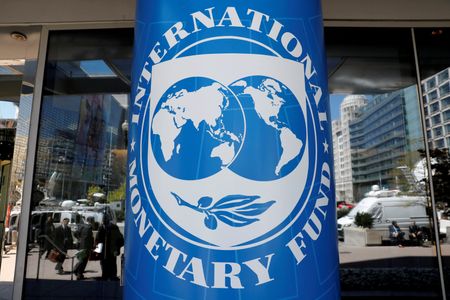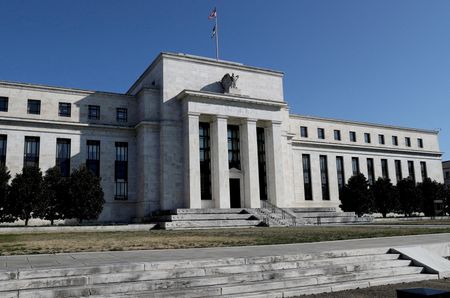By Howard Schneider, William Schomberg and Balazs Koranyi
WASHINGTON/LONDON/FRANKFURT (Reuters) – Despite broad warnings about the economic risks posed by recent stress in the banking sector, global monetary policymakers are keeping their focus squarely on inflation and the need to continue raising interest rates to tame it.
The call for caution has come from top officials at the International Monetary Fund who are worried about a global crack-up, from bond markets flashing recession signals, and from policymakers themselves who say they are monitoring the details of banking data and the mood of industry executives for signs of trouble.
Still, three of the world’s four major central banks at this point are on track to raise interest rates when they next meet, a step U.S. markets bet will set the stage for cuts in borrowing costs soon after as recession arrives.
In their latest World Economic Outlook, IMF officials on Tuesday trimmed their forecast for world growth, but said there were “plausible” scenarios, flowing from the recent failures of Silicon Valley Bank and Signature Bank in the U.S. and the forced merger of Credit Suisse, that could cut growth even deeper, while more serious banking problems and tighter credit could leave the global economy stalled altogether.
In contrast, monetary policymakers, even in the wake of the recent financial stress, seem primed to do more to combat high inflation that they still view as the greater risk.
“The onus remains on ensuring enough monetary tightening is delivered to ‘see the job through’ and sustainably return inflation to target,” Huw Pill, the Bank of England’s chief economist, said last week, warning that inflation risks were “skewed significantly to the upside.”
Though headline inflation in the United Kingdom was set to drop from above 10%, the highest rate in the developed world, Pill said the “potential persistence of domestically generated inflation” remained a barrier to reaching the 2% target.
A similar dilemma is emerging in Europe and the U.S., parts of the world that share a 2% inflation goal and a sense that the underlying pace of price increases has gotten stuck at a level much higher than that.
The outlier remains Japan, where long-stagnant inflation and wage growth are only now showing budding signs of change. Bank of Japan Governor Kazuo Ueda, in his inaugural news conference on Monday, stressed the need to keep an ultra-loose monetary policy to help sustainably achieve a 2% inflation target.
NOTHING ‘BROKEN’ YET
International economic officials gathering in Washington this week for the IMF and World Bank spring meetings can take some comfort that pandemic-era risks are continuing to diminish.
The COVID-19 health crisis has eased, with commerce largely back to normal. What seemed an incipient global recession just months ago has given way to continued, if slow, growth, even in the euro zone where output had seemed on the verge of shrinking.
An aggressive year of central bank rate hikes hasn’t yet “broken” any of the economies involved, with the U.S. unemployment rate at 3.5%, near its lowest level since the late 1960s. Even if borrowing costs are set to move higher, the current tightening cycle is likely nearing its end as officials zero in on a level they feel is adequately restrictive to pull inflation into line.
Still, that terminal rate remains unclear, and the end of synchronized tightening by the Fed, BoE and European Central Bank doesn’t mean tight monetary policy is going away. Far from it. Central bankers have begun to concede a key point: A normalizing global economy won’t foster an easy return to the pre-pandemic era’s low inflation trends.
Developments that policymakers thought would get them far along that road, such as the repair of global supply chains, have taken place as expected. But the help in lowering inflation has been less than anticipated, largely confined to slowing price increases for goods. Price pressures for services have shown little moderation.
‘ENTRENCHED’ INFLATION
In Europe, after dodging recession and weathering a winter with lower-than-anticipated energy prices despite the war in Ukraine, inflation concerns have moved from the oil-driven headline rate to an array of “core” prices that keep rising.
Wages, services and food are driving price growth to the point that the ECB’s attention has shifted almost entirely to underlying inflation on fears that rapid price growth is at risk of getting stuck above target.
Philip Lane, the ECB’s normally cautious chief economist, even put multiple rate hikes on the table as core inflation ticked up to a record-high 5.7% last month. Overall inflation is almost 4 percentage points below its October peak.
“Under our baseline scenario, in order to make sure inflation comes down to 2%, more hikes will be needed,” Lane was quoted as saying by the German newspaper Die Zeit on March 29.
A U.S. measure often cited by Fed officials, the “trimmed mean” inflation rate excluding goods with the largest and smallest price movements, has shown little improvement, moving from 4.75% in August to just 4.59% in February.
The U.S. central bank is expected to increase its benchmark overnight interest rate by another quarter of a percentage point next month, and signal whether more hikes may be warranted. The U.S. labor market remains strong, with inflation now focused in sectors that are both the most labor-intensive and, by some research, the least sensitive to higher rates – bad news for the Fed, and a dynamic that may drive rates higher.
TD Securities macro strategists Jan Groen and Oscar Munoz recently concluded that some of the pandemic-era inflation had become “entrenched,” with the U.S. personal consumption expenditures price index, excluding food and energy costs, likely to get lodged at a rate around 3%.
If that “core” PCE rate, which is closely monitored by the Fed, is as persistent as thought, they wrote, the U.S. central bank will “have to choose between its inflation target or aggressive easing” to deal with an eventual rise in the unemployment rate.
The likely outcome, they said, is that interest rates will remain higher than anticipated as inflation continues to be the priority.
The IMF’s chief economist, Pierre-Olivier Gourinchas, contends that focus is correctly placed given financial stability risks appear for now to have subsided.
“Is it causing potentially catastrophic financial instability further down the road and, as a result, should they sort of refrain from doing this?” he said in an interview with Reuters on Tuesday. “Our assessment on this is no, because the financial instability looks very much contained.”
Moreover, not acting sufficiently to contain inflation would be “creating a problem of its own.”
(Reporting by Howard Schneider, William Schomberg and Balazs Koranyi; additional reporting by David Lawder in Washington and Leika Kihara in Tokyo; Editing by Dan Burns and Paul Simao)


